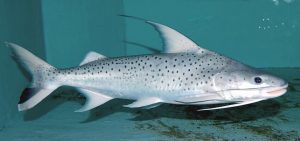– taken from the report 02-2017 –
Pier Aquatics (Wigan, England) came up with a special treat for catfish lovers in September: Two large specimens of the “lince catfish”, Platynematichthys notatus (JARDINE, 1841) could be imported from Peru.
 Only very rarely do specimens of this attractive catfish species ever reach our aquarium. One of the reasons are the high transport costs, which inevitably arise with large catfish. The transport of the specimen shown here from Peru alone cost 815 EUR. A further obstacle is the export ban on so-called edible fish, i.e. fish of all families exceeding a fixed size of 26 cm, which are considered edible fish in their country of origin.
Only very rarely do specimens of this attractive catfish species ever reach our aquarium. One of the reasons are the high transport costs, which inevitably arise with large catfish. The transport of the specimen shown here from Peru alone cost 815 EUR. A further obstacle is the export ban on so-called edible fish, i.e. fish of all families exceeding a fixed size of 26 cm, which are considered edible fish in their country of origin.
P. notatus can be easily identified and distinguished from all other pimelodids by its silvery ground colour, which is often found in Pimelodidae, and the numerous small, dark brown to black spots on its body. The seam of the dorsal as well as the inner seam of the caudal can be dark to deep black. There are few or no spots on the fin membranes. The head is somewhat blunt at the front and less flat or pointed than in most other “Pims”. The hard fin ray of the dorsal, anal and ventral are slightly longer and tapered.
The genus is monotypic, although there is some speculation that different species are currently addressed by the taxon notatus, as the animals currently known as local forms differ slightly in colouration. Many of the large Pimelodids, however, live in very large distribution areas, which can also extend over different river systems. This could explain phenotypic differences. It is assumed that the species is found in all countries eastwards of the Andes in of South America, except Argentina, Paraguay and Uruguay. Type locality is the Rio Branco near Fort St. Joaquin (JARDINE, 1841), a tributary of the Rio Negro, which in turn flows from the north into the Rio Amazonas.
Final sizes of 50-60 cm are said to be normal for this species, which I have seen myself. From the Orinoco basin, however, even larger specimens are reported, which are said to reach a total length of up to one meter (ROMANO, 1985).
Literature:
* Jardine W. in Schomburgk (1841): 181, Pl. 7: The Natural history of fishes of Guiana; ref. 18707
* Romano B. (1985) Peces de Aqua Dulce de Venezuela Vol. I. Editorial Biosfera
Picture: Pier Aquatics